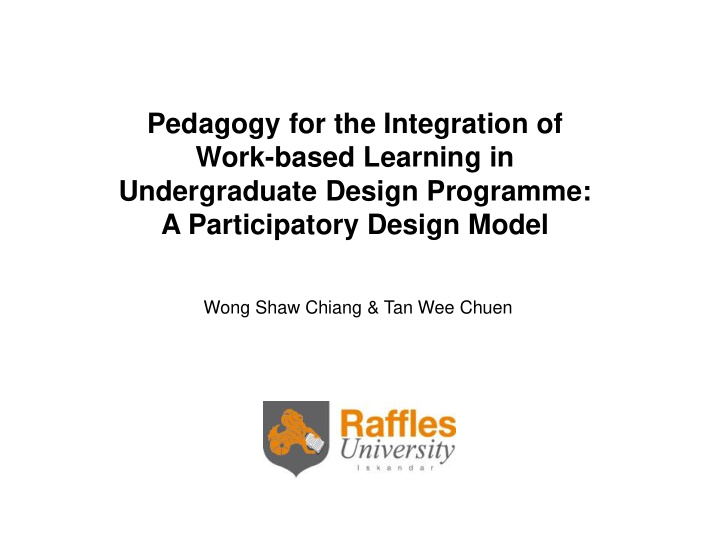



Pedagogy for the Integration of Work-based Learning in Undergraduate Design Programme: A Participatory Design Model Wong Shaw Chiang & Tan Wee Chuen
Acknowledgment The authors would like to express their gratitude to the industry stakeholders, Raffles University Iskandar and students who have agreed to share their work in this paper.
Typical teaching and learning approach applied by most design programmes in the university?
Lecturer Lecturer as client as source of / instructor- information centred Typical teaching and learning approach applied by most design programmes in the university? Students do / Students solve present their works problems / project brief in University given by the lecturer
THE DILEMMA learning is not the consequences of teaching?
Many graduates do not have the (Moha skills and qualifications which match mad Idham the requirements of the industry. Md Razak et al., 2014; Zaliza Hanapi & Mohd Safarin Nordin, 2014)
UNIVERSITY INDUSTRY Level Level
Problem-solving Critical Thinking Creative Thinking UNIVERSITY INDUSTRY Management Level Level Leadership Communication (Che Mohd Zulkifli Che Omar & Shanmuganathan Rajoo, 2016; Zaliza Hanapi & Mohd Safarin Nordin, 2014)
pedagogical process CURRICULUM LEARNING OUTCOMES
Work-based Learning… is an experience- based learning that engages students in experiencing the work role through undertaking the (MQA, work-based project, 2015; Sweet, the production of 2013; goods and services Lemanski, Mewis & while achieving the Overton, learning outcomes. 2011)
pedagogical process CURRICULUM LEARNING OUTCOMES work-based learning
Participatory design process as applied to the project.
“NEW” student-stakeholder interaction based on a cooperative process
Students presented their initial research findings, idea, and solution to the industry stakeholders at their workplace.
Student produced the proposed solution manually.
Feedback from industry stakeholder during sharing session.
Project facilitator conducts Project facilitator provides supporting T&L activities to equip guidance and motivation to the students with the relevant students in working with the knowledge and practical skills stakeholders Pedagogy for integration of work- based learning? Students constantly engage Students deal with real with industry stakeholders at their problems that identified workplace where the learning collaboratively with industry occurs stakeholders
Reflective Journal
Participatory design process as applied to the project.
References Che Mohd Zulkifli Che Omar and Shanmuganathan Rajoo (2016). Unemployment among graduates in Malaysia. International Journal of Economics, Commerce and Management . IV(8). 367-374. Fuller, A. (2003). Participative learning through the work-based route: from apprenticeship to part-time higher education. Symposium on “Higher Education and the Work - based route”. Eurpean Association for Research in to Learning and Instruction Conference held at the University of Padua , Italy. Gardien, P., Djajadiningrat, T., Hummels, C., & Brombacher, A. (2014). Changing your hammer: The implications of paradigmatic innovation for design practice. International Journal of Design , 8(2), 119-139. Lemanski, T., Mewis, R. & Overton, T. (2011). An Introduction to Work-based Learning . Hull: UK Physical Science Centre, University of Hull Mohamad Idham Md Razak, Asliza Mohd Yusof, Wan Nor Syazana, Wan Effa Jaafar and Adi Hakim Talib (2014). Factors influencing unemployment among Graduates in Malaysia - An overview. Journal of Economics and Sustainable Development. 5(11). 168-173 MQA (2015). Guidelines to Good Practices: Work based learning . PJ: Malaysian Qualifications Agency Sweet, R. (2013). Work-based learning: Why? How. In UNESCO-UNEVOC-Revisiting global trends in TVET (pp. 164-202). Retrieved from: http://www.unevoc.unesco.org/fileadmin/up/2013_epub_ revisiting_ global_trends_in_tvet_chapter5.pdf Zaliza Hanapi, and Mohd Safarin Nordin (2014). Unemployment among Malaysia graduates: Graduates’ attributes , lecturers’ competency and quality of education. Procedia -Social and Behavioral Sciences, 112(2014), 1056-1063.
Recommend
More recommend